Leveraging design and user research to inspire the next generation of video conversations
"iF propelled the overall design of our product with thorough research, actionable insights, and valuable designs. After this process, we have a much better understanding of how users interact with our platform." - Forest Key, CEO Voodle Inc.
Overview
As companies were forced to rapidly adapt to the challenges of virtual work, one element that proved especially challenging to preserve was culture. Many times aspects of culture are formed in informal settings–around the water cooler, grabbing a bite for lunch, or on the elevator. While there are now many virtual options for formal meeting times, research indicates that companies have struggled to keep the more informal social bonds that drive collaboration alive.
Voodle identified an opportunity to bring short-form video to the workspace. Their video platform addresses the wear and tear of virtual work by connecting short videos into ongoing, asynchronous conversations for working teams. App “voodles” might help teams foster collaboration, inspiration, and even align on business decisions. All this could happen without scheduling a single meeting - or sacrificing the personality, tone, and human emphasis that makes video conversations richer than text.
While Voodle had the technical prowess and a clear white space their product could fill, they were finding they had a “zombie problem”: users would download the app, and stop engaging before taking the time to create or share voodles with their teammates. Voodle came to iF with a twofold challenge: What would inspire new users to engage with Voodle from onboarding through inviting teammates? And, once onboarded, what would inspire teams to escalate their use into ongoing engagement?
What We Made
Voodle needed fast, flexible design ideas based on solid user research to support their active product. We planned four month-long design sprints. Each sprint included ideation, user testing, and a concept or UI handoff ready for immediate inclusion in Voodle’s work.
Research techniques were key to validating our ideas. We recruited teams of actual co-workers, and led them through both solo and group research activities. This helped us identify the mindsets of individual users, as well as how needs and values shifted for social groups. Activities were conducted through a combination of design prototypes and the Voodle app itself. In some cases, we used smoke-and-mirrors Wizard of Oz techniques to gather quick feedback on features that were otherwise time-consuming to build.
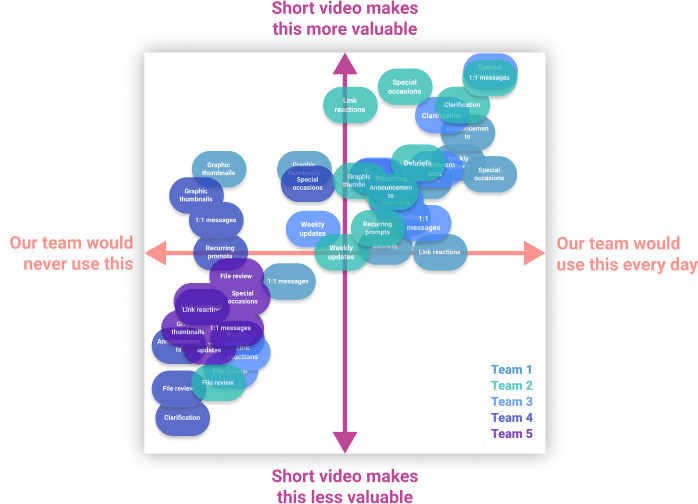
Sprints 1 and 2 also showed how important it was to let users create their first Voodle in a private, low-risk environment before introducing them to the full app. Based on this insight, we delivered designs for a new onboarding flow that created a relaxed, playful mindset with clear content visibility messaging.
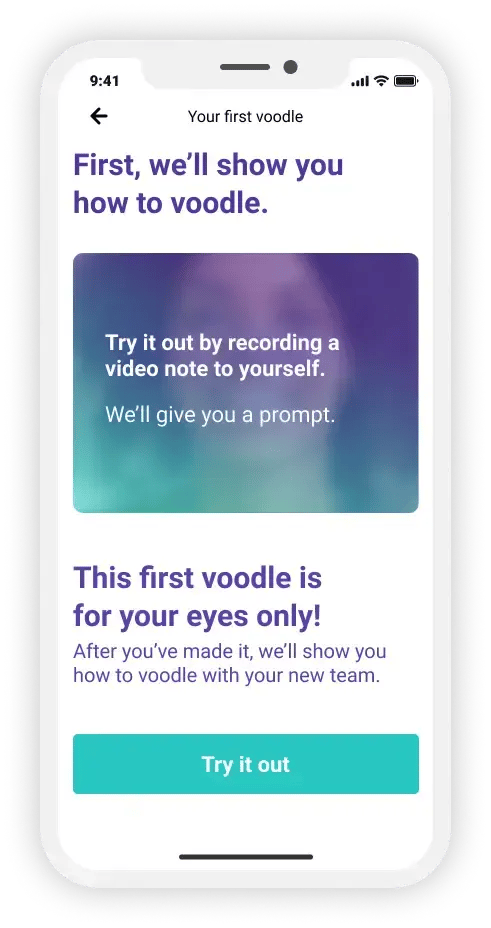

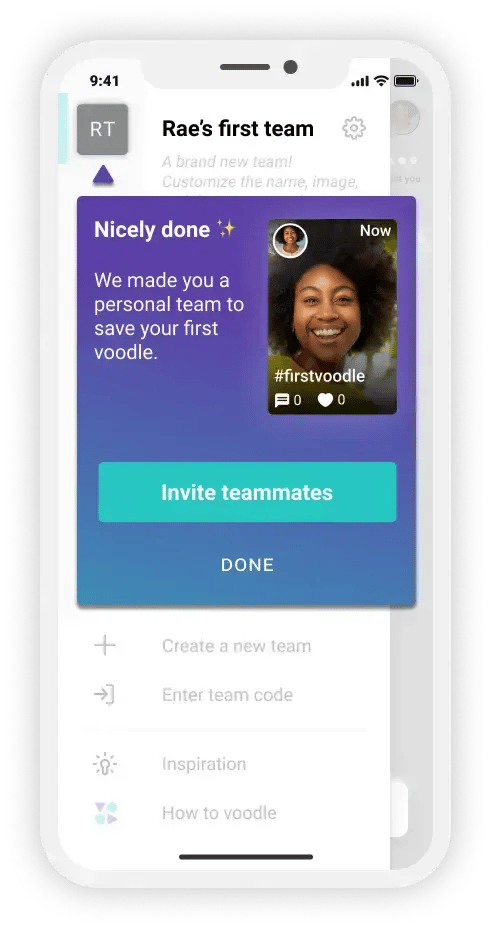

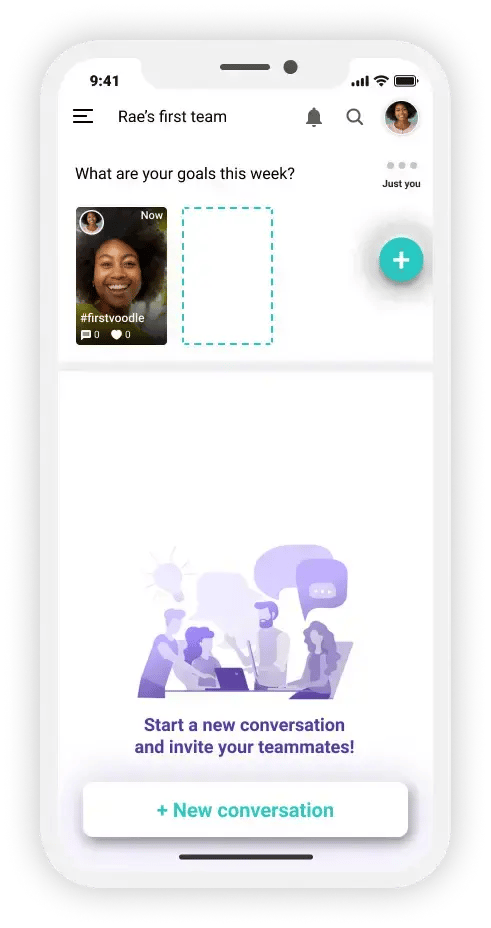
Our final two sprints explored ongoing team motivation. We designed and tested features to support the first month of team voodling, including a prompt feature that celebrated user achievements and suggested new types of conversations. We also improved the reply experience while watching videos - lowering the friction of joining a conversation.
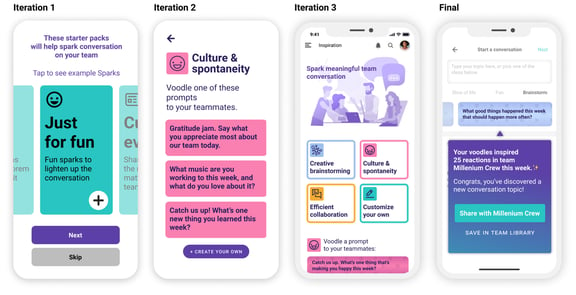

By structuring our work in four iterative sprints, we helped Voodle pivot and adapt as research sessions uncovered new information. Frequent share outs and collaboration helped the Voodle team apply our design concepts immediately after or even during each sprint. We turned research insights and feedback into actionable design improvements on a timeline that met Voodle’s needs, with many of our recommendations planned for implementation before the project’s end.
Impact
iF’s final design work for Voodle revolved around three key insights. These insights recommended how Voodle could best entice users to explore their platform, invite teammates, and energize ongoing conversations.
Insight 1: Encourage all kinds of power-users
It only takes one or two enthusiastic teammates to discover an app like Voodle and start sharing infectious content. Just the experience of seeing teammate’s voodles can inspire people initially uncomfortable with recording videos. We focused our design features on unblocking potential power-users, rather than trying to ensure full-team adoption.
Offering private groups and hyper-clear visibility settings made new users more comfortable creating early voodles. Even power-users wanted to test voodling with small groups of trusted co-workers before sharing with full teams; and they wanted to be sure they knew exactly who would see their content.
We also identified culture conversation topics as a way to broaden the range of teammates who might discover and champion Voodle. This empowered more junior employees to become team evangelists. They felt more comfortable inviting peers, or even higher-ranking coworkers, when conversations had an extracurricular focus.
Insight 2: Craft response moments
We all love getting immersed in video. As watchers, we get to sit back and take in somebody else’s point of view. But while short videos create captivating “watch” experiences, it’s also difficult for users to know when or how to respond.
Pauses at the end of videos and conversations, create the space for users to contribute their voice. We made this an organic and undisruptive part of the “watch” flow by animating a response button into view between videos, and celebrating the moments when users finished watching a whole conversation with an additional “add your voice” nudge.
Flexible response options, giving video-shy users multiple ways to participate in conversations without recording full videos. Once they’ve begun engaging with Voodle content, they may begin to feel comfortable turning on their cameras.
Insight 3: Prompt unexpected connections
Throughout our research, moments of fun, spontaneous connection were most likely to inspire and support adoption. Participants got most excited about Voodle’s potential after learning new things about their colleagues, or seeing the people they worked with in different ways.
We designed a prompt feature to increase the spontaneity and novelty of Voodle connection moments.
It’s always easier to respond to a question than to start a conversation from scratch; so we suggested an array of starter topics to both set the tone and lower the barrier to voodling.
During onboarding, prompts helped reduce ambiguity and anxiety as users recorded their first voodle. Users got a clear visual cue just below their camera to focus on while recording, and avoided the cold-open problem of not knowing what to say.
Prompts also helped new users imagine what kind of conversations they might have with co-workers - and increased their interest in sharing voodles with other people.
As usage continues, evergreen prompts become fun ways to inspire new waves of conversation—relieving managers and extroverts from the pressure to keep conversations fresh.
Equipped with robust research around their value proposition, as well as user-based learnings they implemented along the way, Voodle is now prepared to further refine their app to cater to the needs of their users throughout their entire customer journey.
